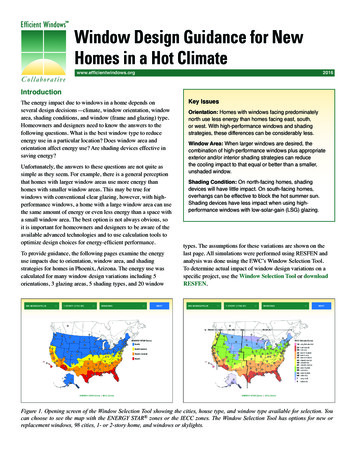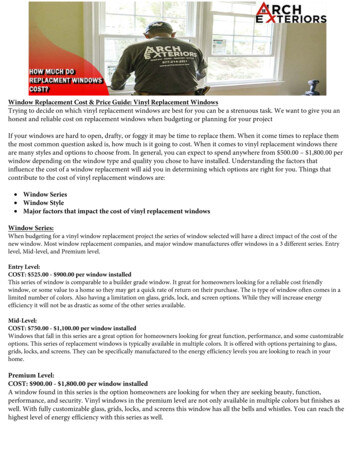
Transcription
Window Design Guidance for NewHomes in a Hot Climatewww.efficientwindows.orgIntroductionThe energy impact due to windows in a home depends onseveral design decisions—climate, window orientation, windowarea, shading conditions, and window (frame and glazing) type.Homeowners and designers need to know the answers to thefollowing questions. What is the best window type to reduceenergy use in a particular location? Does window area andorientation affect energy use? Are shading devices effective insaving energy?Unfortunately, the answers to these questions are not quite assimple as they seem. For example, there is a general perceptionthat homes with larger window areas use more energy thanhomes with smaller window areas. This may be true forwindows with conventional clear glazing, however, with highperformance windows, a home with a large window area can usethe same amount of energy or even less energy than a space witha small window area. The best option is not always obvious, soit is important for homeowners and designers to be aware of theavailable advanced technologies and to use calculation tools tooptimize design choices for energy-efficient performance.To provide guidance, the following pages examine the energyuse impacts due to orientation, window area, and shadingstrategies for homes in Phoenix, Arizona. The energy use wascalculated for many window design variations including 5orientations, 3 glazing areas, 5 shading types, and 20 window2016Key IssuesOrientation: Homes with windows facing predominatelynorth use less energy than homes facing east, south,or west. With high-performance windows and shadingstrategies, these differences can be considerably less.Window Area: When larger windows are desired, thecombination of high-performance windows plus appropriateexterior and/or interior shading strategies can reducethe cooling impact to that equal or better than a smaller,unshaded window.Shading Condition: On north-facing homes, shadingdevices will have little impact. On south-facing homes,overhangs can be effective to block the hot summer sun.Shading devices have less impact when using highperformance windows with low-solar-gain (LSG) glazing.types. The assumptions for these variations are shown on thelast page. All simulations were performed using RESFEN andanalysis was done using the EWC’s Window Selection Tool.To determine actual impact of window design variations on aspecific project, use the Window Selection Tool or downloadRESFEN.Figure 1. Opening screen of the Window Selection Tool showing the cities, house type, and window type available for selection. Youcan choose to see the map with the ENERGY STAR zones or the IECC zones. The Window Selection Tool has options for new orreplacement windows, 98 cities, 1- or 2-story home, and windows or skylights.
Guidance for New Windows in a Hot ClimatePage 22016Copyright 2016, Efficient Windows CollaborativeAll rights reserved.are not as critical when high-performance windows are used.Figure 3 illustrates the impact of 5 different window orientationson annual energy costs in Phoenix, Arizona. In all cases, thewindows have typical shading. As expected, orientation hasa negative impact when clear, single-glazed windows areused. When high-performance windows with a low-solar-gain(LSG) low-E coatings are used, the window orientation has adiminished impact on energy use.OrientationFigure 2 shows the range of possible annual energy costs for thedesign variations grouped by orientation. This figure shows: The impact of orientation on energy use is not the same for allwindows. Under certain conditions, very low energy use can be achievedwith any orientation. West-facing designs use the most energy. North-facing designs use the least energy. Orientation has a reduced impact on energy performancewhen high-performance windows are used with low-solar-gain(LSG) glazing systems (windows 6, 11, 17, and 20).Impact of Window Orienta on 1500hea ngcooling 1200Annual Energy CostsIn the past, windows had little capability in reducing solar heatgain, so the design of energy-efficient houses in hot climatesevolved to protect windows from significant solar gain. Inwarm to hot climates these older strategies included facing mostwindows north, where there is little direct exposure, or to thesouth where overhangs can be designed to keep out most of thehot summer sun. West windows are subject to the full force ofthe strong afternoon sun, at a time of day when temperaturesgenerally climb to their peak. East windows have the sameproblem in the morning hours, but air temperatures tend to becooler. 900 600 300 0NESW QSingle, ClearMetal FrameIn spite of energy concerns, a house may have a spectacularview or other amenity to the east or west. Fortunately, thetraditional patterns of avoiding east- and west-facing windowsN ESW QDouble, LSG Low-EMetal FrameThermal BreakNESW QDouble, LSG Low-ENon Metal FrameThermally ImprovedFigure 3. Impact of orientation for 3 windows in Phoenix, AZ. Theresults are for 15% window area with typical shading.Range of Performance by Orienta on 2000Low-E GlazingLow-E GlazingLow-E Glazing 1800Annual Energy Costs 1600 1400 1200 1000 800 600 400SingleGlazingMetal Frame1SingleGlazingNon Metal FrameDouble Glazing234Metal Thermal Break Frame5678910111213Double GlazingTriple GlazingNon Metal Thermally Improved geFigure 2. Annual energy costs (heating & cooling) for all window design variations by orientation in Phoenix, AZ.1920
Guidance for New Windows in a Hot ClimatePage 32016Copyright 2016, Efficient Windows CollaborativeAll rights reserved.shading. With single glazing, increasing the glazing area has avery significant impact on the cooling load. The annual energyuse for a house with low-solar-gain (LSG) low-E glazingexhibits the same pattern of increasing cooling load as thewindow area increases, but the differences are minimal.Window AreaFigure 4 shows the range of possible annual energy costs for thedesign variations grouped by window area. This figure shows: The impact of window area on energy use is not the same forall windows. Larger window areas can have much worse performance whenusing windows with clear or high-solar-gain (HSG) glazing(windows 4, 9, 15, and 18). Under certain conditions, very low energy use can be achievedwith any window area when using windows with moderate(MSG) (windows 5, 10, 16, and 19) or low-solar-gain (LSG)glazing (windows 6, 11, 17, and 20).Impact of Window Area 1500hea ngcoolingAnnual Energy Costs 1200Another traditional guideline to reduce solar heat gain is toreduce the home’s total glazing area. This can be effective withany type of window, but it is particularly important when lessefficient windows are used. Because of the need for daylighting,views, and natural ventilation, significantly reducing windowarea may not be a realistic or desirable strategy. Reducingwindow area to reduce energy use is no longer significant, ifhighly efficient windows are used. 900 600 300 0Figure 5 illustrates the impact of 3 different glazing areas(small-10%, moderate-15%, large-20%) on the annual energycosts for a house in Phoenix, Arizona. In all cases, the windowsare equally distributed on the four orientations with typical10% 15% 20%10% 15% 20%10% 15% 20%Single, ClearMetal FrameDouble, LSG Low-EMetal FrameThermal BreakDouble, LSG Low-ENon Metal FrameThermally ImprovedFigure 5. Impact of window for 3 windows in Phoenix, AZ. Theresults are for equal orientation with typical shading.Range of Performance by Window Area 2000Low-E GlazingLow-E GlazingLow-E Glazing 1800Annual Energy Costs 1600 1400 1200 1000 800 600 400SingleGlazingMetal Frame1SingleGlazingNon Metal FrameDouble Glazing234Metal Thermal Break Frame5678910111213Double GlazingTriple GlazingNon Metal Thermally Improved Frame1415161718Windows10%15%20%AverageFigure 4. Annual energy costs (heating & cooling) for all window design variations by window area in Phoenix, AZ.1920
Guidance for New Windows in a Hot ClimatePage 42016Copyright 2016, Efficient Windows CollaborativeAll rights reserved.ShadingFigure 6 shows the range of possible energy costs for the designvariations grouped by shading condition. This figure shows: The impact of shading strategies on energy use is not the samefor all windows. Under certain conditions, very low energy use can be achievedwith any shading strategy on any orientation. Windows with no shading and with overhangs perform theworst. The impact of shading strategies is reduced when usinghigh-performance windows with moderate-(MSG) (windows5, 10, 16, and 19) or low-solar-gain (LSG) glazing systems(windows 6, 11, 17, and 20).Figure 7. Shading strategies can reduce the solar heat gain thatenters through the window.Most homeowners use some form of interior window treatmentsuch as drapes, blinds, or shades on their windows. In additionto their decorative aspects, drapes and curtains are used byhomeowners to control privacy and daylight, provide protectionfrom overheating, and reduce the fading of fabrics. To mosteffectively reduce solar heat gain, the drapery used to block thesunlight should have high reflectance and low transmittance.The impact of drapery on the solar heat gain is proportionallylessened as the window is shaded by other methods, such asexterior shading or tinted glass. The main disadvantage of drapesand other interior devices as solar control measures is that oncethe solar energy has entered the room through a window, a largeproportion of the energy absorbed by the shading system willremain inside the house as heat gain.Any effort to shade traditional windows has had great benefitsin terms of comfort and energy use. The best place to shade awindow is on the outside, before the sun strikes the window.Exterior shading devices have long been considered the mosteffective way to reduce solar heat gain into a home. The mostcommon approach is the fixed overhang. For south-facingwindows, overhangs can be sized to block out much of thesummer sun. Overhangs have the advantage of reducing heatgain and glare without diminishing the view. Other exteriordevices include grills, awnings, shutters, roll-down shades/shutters, and canopies. The choice of shading strategy is oftendistinctly regional, based on local traditions. The drawback ofsome shading devices is that they block light and view.Range of Performance by Shading Type 2000Low-E GlazingLow-E GlazingLow-E Glazing 1800Annual Energy Costs 1600 1400 1200 1000 800 600 400SingleGlazingMetal Frame1SingleGlazingNon Metal FrameDouble Glazing234Metal Thermal Break Frame5678910111213Double GlazingTriple GlazingNon Metal Thermally Improved MaximumAverageFigure 6. Annual energy costs (heating & cooling) for all window design variations by shading type in Phoenix, AZ.1920
Guidance for New Windows in a Hot ClimatePage 52016Copyright 2016, Efficient Windows CollaborativeAll rights reserved.By using high-performance windows to provide the necessarysolar control, there are two important benefits: there is less needfor operating the shades, and the window is covered less of thetime, resulting in increased daylight and unobstructed views.If your goal is to minimize cooling energy use, or you livein a house without air-conditioning in a hot climate, then thecombination of good shade management with low-solar-heatgain (LSG) windows will be the best strategy.A broad-leafed tree is good at providing cool shade in thesummer. In addition to shading the building from directsun, trees have been found to reduce the temperature of airimmediately around them by as much as 10 F (5 C) belowthe temperature of the surrounding air due to evaporation ofmoisture. A window shaded with vegetation can have fullshade in the summer, while enhancing the view and perhaps theventilation. Trees and bushes can provide strategic shade fromlow east or west sun angles that are extremely difficult to shadearchitecturally.Figure 8 illustrates the impact of 5 different shading strategies(typical, none, interior blinds, overhangs, maximum) on theannual energy costs for a house in Phoenix, Arizona. In all cases,the windows are equally distributed on the four orientations witha moderate window area. With single glazing, using no shadingor overhangs significant impacts the cooling load. Overhangs aremuch less effective against the lower angles of the east and westsun, but can be quite effective on the south orientation. Relianceon any form of shading is not nearly as important, however,when windows with low-solar-heat-gain (LSG) glazing systemsare used.Impact of Shading Type 1500hea ngcooling 1200Annual Energy CostsBlinds and shades primarily provide light and privacy controlbut they also can have an impact on controlling solar heat gain.These include horizontal Venetian blinds, miniblinds, verticalslatted blinds, pleated and honeycomb shades, and roll-downshades—all of which can be made of various materials. Unlikeother strategies to reduce heat gain, such as overhangs, interiorshades generally require consistent, active operation by theoccupant. Unfortunately, when shades are down, daylight andview are diminished or excluded completely. It is unlikelythat anyone would operate all shades in a consistent, optimalpattern as they are often assumed to be operated in computersimulations. Motorized and automated shading systems arewidely available to solve these operational problems. The controlsystems can be automated using sensors, time clocks, or a homeautomation system. They can also be directly controlled by theoccupants. 900 600 300 0Typ None VB OH MaxTyp None VB OH MaxTyp None VB OH MaxSingle, ClearMetal FrameDouble, LSG Low-EMetal FrameThermal BreakDouble, LSG Low-ENon Metal FrameThermally ImprovedFigure 8. Impact of window for 3 windows in Phoenix, AZ. Theresults are for equal orientation with typical shading.
Guidance for New Windows in a Hot ClimatePage 62016Copyright 2016, Efficient Windows CollaborativeAll rights reserved.ComfortThermal comfort is that condition of mind that expressessatisfaction with the thermal environment. There are largevariations, both physiologically and psychologically, fromperson to person, so it is difficult to satisfy everyone in a space.Direct sun has obvious impacts on thermal comfort. During coldperiods, limited solar radiation can be a pleasant sensation. Butduring warm or hot weather, it invariably causes discomfort. Justas people turn up the heat to compensate for cold windows inwinter, they may use more air-conditioning to counter the effectsof warm window surfaces and sunlight in summer.To take into account the effect of solar radiation, ResearchersPeter Lyons and Dariush Arasteh adapted the estimation ofPercent People Dissatisfied (PPD) when direct solar radiationwas present (Figure 9). The PPD is calculated from the netPredicted Mean Vote (PMV).Figure 9. Fanger PPD-PMV relationship showing adjustment forsolar load (Lyons and Arasteh, 1999) and incorporated into theEWC Comfort Metric.for windows. This Comfort Metric is limited to a worst-casescenario of a large west-facing window and summer day andwinter night conditions. Windows below a level of 88 discomforthours received a “Neutral” rating—which is good rating.The Efficient Window Collaborative has a Comfort Metricas part of it’s online Window Selection Tool and it is uniqueand innovative for it is the first quantitative comfort tWarmNeutralNeutralFigure 10. Winter comfort rankings for 20 windows in Phoenix, AZ.NeutralNeutral
Guidance for New Windows in a Hot ClimatePage 72016Copyright 2016, Efficient Windows CollaborativeAll rights reserved.The neutral level is approximately 1% of the hours in a year.HVAC equipment sizing also use the 1% thresholds on weatherconditions.Figure 10 illustrates hours summer discomfort for each of the 20windows in Phoenix, Arizona. The summer ranking levels matchup well with type of low-E used in the glazing systems. Anlow-solar-gain (LSG) below 0.25 will be neutral and moderatesolar-gain (MSG) or high-solar-gain (HSG) will be hot. In asouthern climate, it is recommended the LSG glazing systemsare always used for optimal comfort, as well as for energysavings.The Figure 11 illustrates hours winter discomfort for each ofthe 20 windows in Phoenix, Arizona. The winter ranking levelsshow frame and glazing type do not make much of a negativeimpact on comfort unless using clear or tinted glass. Dependingon if your location requires winter heating, when selectingwindows for a southern climate the focus should be on reducingand/or redirecting the solar heat gain. This is most effectivelydone by using low-solar-gain (LSG) glazing.When choosing windows for your particular climate, make surethat you take into account, not only the design of your home,but also the thermal impacts of both the heating and the coolingseasons. For comfort issues may occur as a result of either ofthose situations.ColdColdCoolCoolNeutral Neutral NeutralNeutralNeutral Neutral NeutralNeutral Neutral Neutral Neutral Neutral Neutral Neutral NeutralFigure 11. Winter comfort rankings for 20 windows in Phoenix, AZ.
Guidance for New Windows in a Hot ClimatePage 82016Copyright 2016, Efficient Windows CollaborativeAll rights reserved.AssumptionsThe following assumptions are used in the Window SelectionTool for all energy use calculations presented in this designguide. The annual energy performance figures were generatedwith RESFEN6 provided by Lawrence Berkeley NationalLaboratory. The annual costs are for space heating and spacecooling only and thus will be less than total utility bills. Costsfor lights, appliances, hot water, cooking, and other uses are notincluded. Natural gas prices are based on state-specific averagenatural gas retail price data for the heating season (November–March) for the years 2013–2015. Electricity prices are based onaverage state-specific electricity retail price data for the coolingseasons (May–September) of 2013–2015. All price data is fromthe Energy Information Administration (EIA).coatings, and tints. The Window Selection Tool models theperformance of 23 window systems (20 of which are representedin this document), representative of the breadth of optionsavailable. U-factor and solar heat gain coefficient (SHGC) arefor the total window including frame. For ease of comparingthe performance of glass features, all high-performance glazingsystems in the Window Selection Tool are modeled with anargon fill. All specific simulation assumptions for this documentcan be found on the EWC web site as part of the WindowSelection Tool.The HouseThe house used in the simulations for this guide is a 2600 squarefoot, two-story new house. The mechanical system uses a gasfurnace for heating and electric air conditioning for cooling.The foundation includes a slab-on-grade system. The buildingenvelope consists of R13 walls and R30 roof.House OrientationOrientation of the windows of the house are available inequal(the windows are equally distributed on all 4 sides), north,east, south and west (55% of the window area is on the dominantorientation with 15% on remaining 3 orientations).Window-to-Floor RatioWindow sizes were modeled with a fenestration window-to-floorarea ratio (which includes the area of the whole window withframe). Window-to-floor ratios include 10% (260 square feet ofwindow area), 15% (390 square feet of window area), and 20%(520 square feet of window area).Shading SystemsOverhangs were mounted directly above the window framewith a 2-foot projection and extend the entire width of thewindow. Interior Venetian blinds were simulated so that theslats would have a seasonal SHGC multiplier (summer 0.80,winter 0.90). Typical shading represents a statistically averagesolar gain reduction which includes interior shades, 1-footoverhang, adjacent buildings 20 feet away, and other sources ofheat gain reduction such as insect screens and trees. Maximumshading takes into account interior shades, 2-foot overhangs andobstructions that represent adjacent buildings and vegetation.Window SystemThere are hundreds of glazing systems available in the markettoday, with varying combinations of glass panes, specialFor More InformationVisit the Efficient Windows Collaborative (EWC) formore information. The EWC web site provides unbiasedinformation on: Benefits of efficient windows and how windows work; How to select an efficient window using the WindowSelection Tool EWC members that provide efficient windows.Follow witter.com/EWCwindows
Figure 4. Annual energy costs (heating & cooling) for all window design variations by window area in Phoenix, AZ. Figure 5. Impact of window for 3 windows in Phoenix, AZ. The results are for equal orientation with typical shading. 0 300 600 900 1500 1200 Annual Energy Cost s Impact of Window Area hea ng cooling Single, Clear Metal Frame










